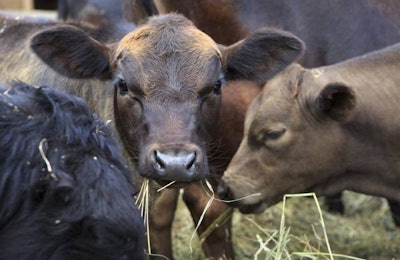
The beef industry learned some lessons in handling a major public relations challenge in June after a heat crisis caused the deaths of several thousand cattle in southwestern Kansas. But those are lessons that can be applicable to people in the poultry and pork industries, as well.
Dr. Tera Barnhardt, a veterinary consultant for Cattle Empire, one of several companies that was hit by the widespread losses in June, spoke of her experiences with the situation during the August 31 webinar, “Communicating Through Disaster.” The webinar was hosted by the National Institute for Animal Agriculture.
What happened
Barnhardt had enough on her mind during the heat emergency in mid-June. She had just given birth to a son and hadn’t even left the hospital at the time.
But she did notice on June 11 that outside of the hospital stood a flagpole that had both an American flag and a Kansas flag attached to it. Those two flags, which ordinarily would have been flapping in the wind, were drooping and perfectly still. The wind speed was less than 7 miles per hour.
Just prior to this time, the areas of Haskell and Grant counties – the two counties hardest hit – had just received 3 inches of rain after a drought that had lasted for more than 200 days.
Then, after a brief cooling period when that rain fell, the temperature rose to about 105 degrees, she said.
That trio of conditions led to what Barnhardt described as a “heat index crisis.”
“Cattle in general can dissipate heat and acclimate to heat very well,” said Barnhardt. “Our perfect storm in this area was that we were receiving such cool weather, and then this sudden change (happened) on June 11.”
The weather didn’t cool off that evening, and feedyard workers the following morning discovered that “disaster happened.” Several days of heat losses in those two counties followed.
Viral video
A video of the cattle losses was filmed, and it began to circulate. That video, she said, was not shot by an intruding activist, but it was “probably taken by an employee of that feedyard. It was someone who belonged in the yard.”
Barnhardt received that video via text, along with questions as to what happened. The problem was, people who saw that video only saw cattle that had died in the heat, and no context accompanied it.
Barnhardt explained to the person who sent her the video that it was a matter of heat stress, and she advised not to further share it because the video had no context.
But the problem was, other people had seen the video. It was shared on TikTok, and inflammatory and inaccurate words started to flow.
“It went viral and went out of control. I was not expecting it to go viral,” she said.
And as a result, Barnhardt was inundated with calls, texts and Facebook messages.
She felt like she needed to fill “a void of communication.”
“People were coming up with their reasoning as to why this happened. I believe our biggest issue with this from an animal agriculture standpoint was a lack of context,” Barnhardt explained. “I tried to offer context in a Facebook response, without saying it was less than a 2% loss. That doesn’t bode well with our consumer or people who are already on the conspiracy theory train, so we have to combat that with a little softer messaging.”
The days before TikTok
Barnhardt said the response to the cattle deaths in Grant and Haskell counties shows how much social media has changed things.
She referenced a time in 2010, when she was a veterinary student. Then, a similar situation with cattle losses in Barton County – in central Kansas – occurred. About 2% of the cattle on a feeder operation there died. But that incident was not widely known by the general public. In fact, many of Barnhardt’s veterinarian friends did not know about it.
“There was not the sharing capability then. TikTok didn’t hit the scene yet,” she said. “That just goes to show us … not very long ago there was an event that was very similar in numbers and severity that got zero traction because nobody shared a video.”
The communication challenge
Barnhardt described the June happenings as “a big eye opener.”
The biggest problem is that when misinformation is spread, it can be difficult to set the record straight.
“Our industry needed to start communicating and connecting with consumers so we could combat this TikTok viral video with good information from people with their boots on the ground,” she said.
But those people closest to the situation, like Barnhardt, are already stressed out and emotional.
“I thought to myself, ‘somebody else needs to take this torch. Somebody else needs to deal with this because we are busy.’” Barnhardt said. “But, the people who have the most credibility in that moment are the people with the boots on the ground.”
But other people in agriculture can support those most directly connected to an animal agriculture emergency, and that support should be shown across the various sectors, she said.
“We need to be able to support them as an industry. We need to figure out a way to deploy communications and expertise across all parts of animal agriculture. Our brothers and sisters in poultry and pork deal with this a lot as well. They might have situations to where they are so busy they can’t handle it. They can’t be the communicators, but they need to be, and we need to support them,” she said.
“That’s just one of many challenges moving forward. We can do better. It’s going to take a team approach to do that.”
During the webinar, Barnhardt also addressed challenges with rendering and carcass disposal.

















